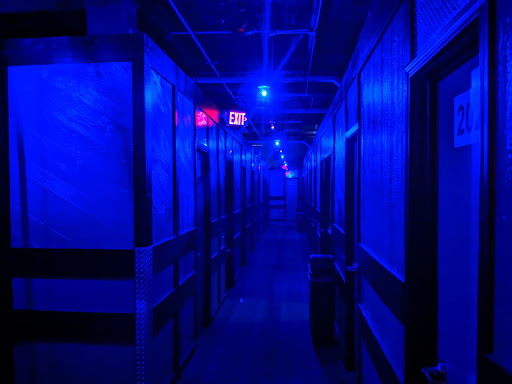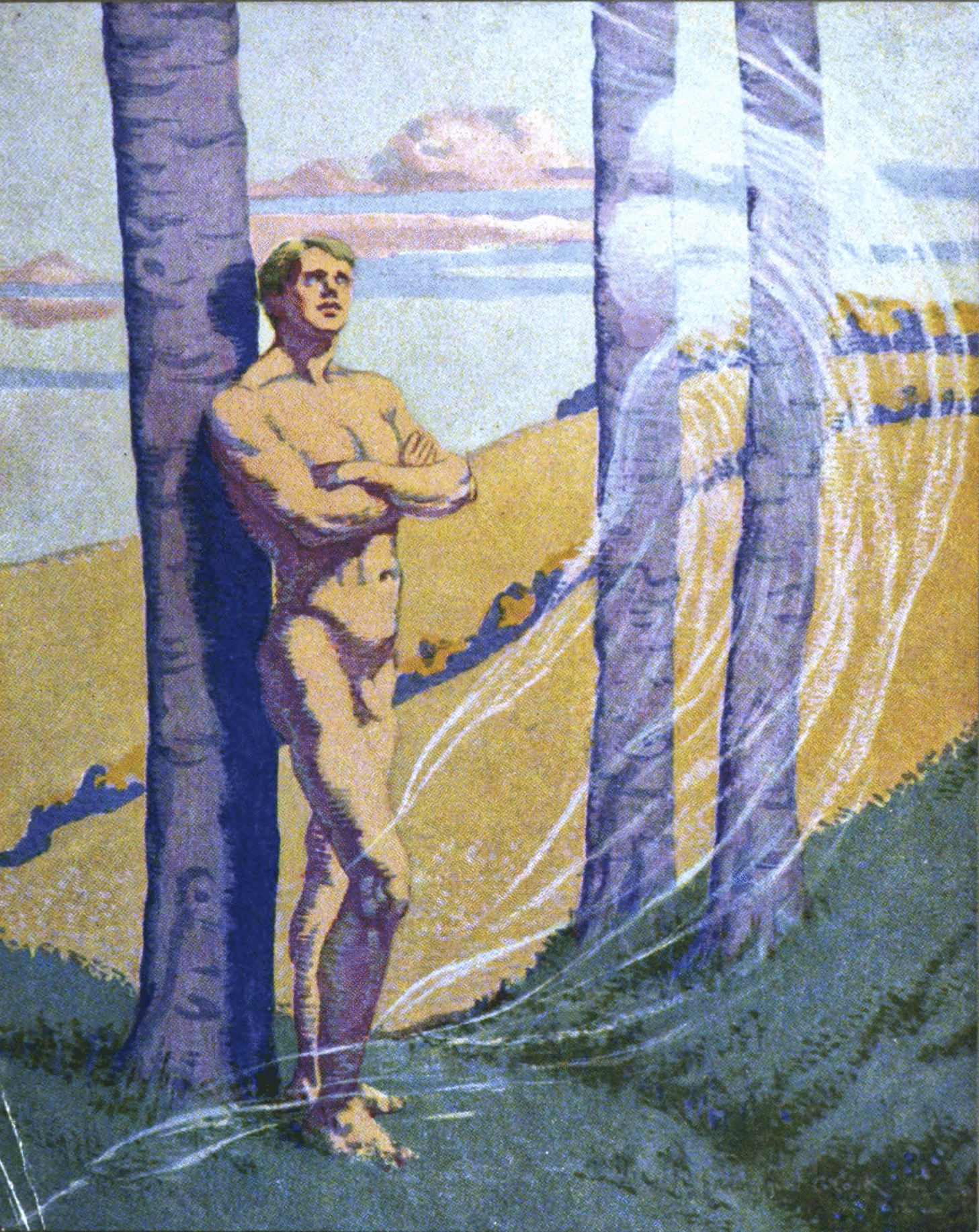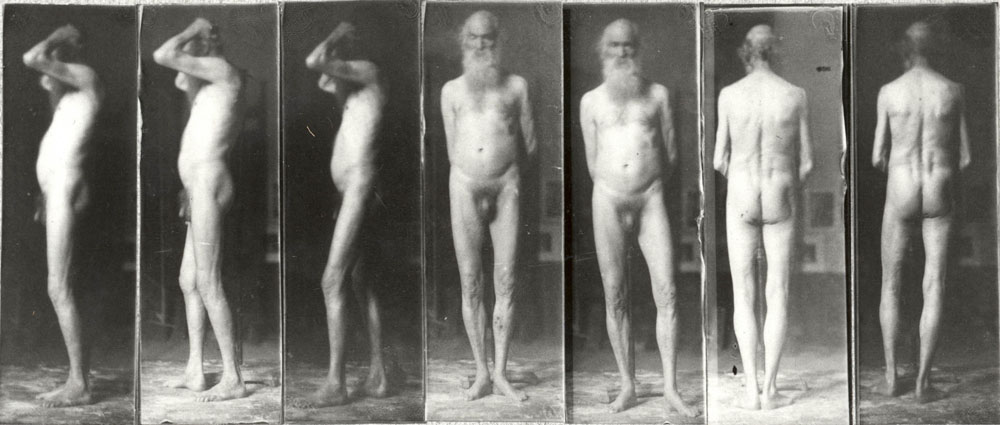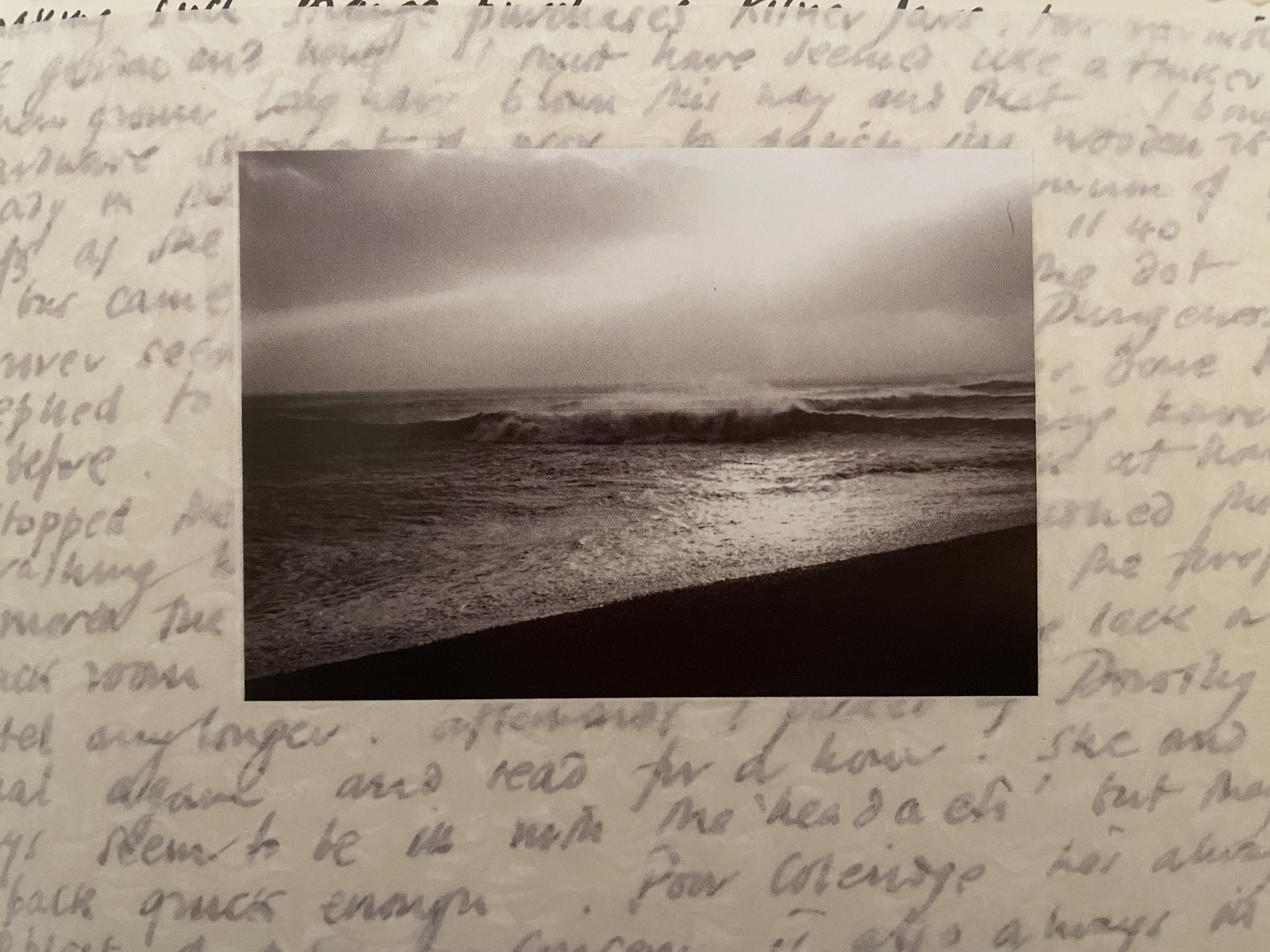Writing and research
Essays
“A Soft, Sympathetic Touch: Walt Whitman and the Eroticism of Wind,” Venti Journal, https://www.venti-journal.com/wesley-cornwell
Conference papers
“Losing the form, feeling the heat,” PopMeC | September 4, 2023 (upcoming)
“Secret violets: Derek Jarman on gardening and grieving,” NYU Department of German | April 27, 2023
“The Rhythm of Shadows: Anthony McCall and the Cinematic Temporality of Architecture,” GSU Film and Media Studies Conference | February 24, 2023
“Blue; or, the queer geography of human limits,” Northwestern Backward Glances Conference | September 30, 2022
“On shadows and other queer becomings,” UCLA Q-Grad Conference | May 27, 2022
See below for some texts, images, and objects I’m writing with and about:
Blue; or, the queer geography of human limits
A bright field of electric blue fills the screen; it is a hungry, piercing color, a blue so sharp it stings. Derek Jarman’s Blue (1993) envelops the viewer in a sea of intense, saturated color that is — in turn — entrancing, disquieting, painful, and serene. This searing blue is accompanied by a palimpsestic soundtrack that layers the philosophic, poetic, historic, and autobiographic, principally following Jarman’s experience of living and dying with AIDS, his failing sight due to cytomegalovirus, and the complexity of navigating an inadequate medical system. “Veer[ing] between lulling metaphysical speculation and brutal physical reality,”1 Blue is (to borrow the film’s own words) a “poetry of fire,”2 a blazing record of the complexities of individual queer lives at a moment of sweeping, systemic queer death. In short, the film renders sensible Maggie Nelson’s stunning description of “death’approach as the swell of a wave — a towering wall of blue.”3
What happens when this wave crashes over us, plunging us into a fathomless, boundaryless ocean of blue? Or, in more theoretical terms, what is the relationship between sensorial intensity and the (de)formation of corporeal boundaries — what happens when blue transcends the solemn geography of human limits? Furthermore, how does the transfiguration of boundaries cleave the self from the body, disrupting the cohesion and selfidenticality of the self? Lastly, how do disembodiment and desubjugation allow for the possibility of queer (perhaps even fleetingly utopian) forms of sociality and what are the risks? In pursuit of answers to these questions, this essay proceeds as “an experiment, not a judgement,”4 gathering flashes and sparks of blue through which we might better glimpse how sensorial saturation mediates the disaggregation of the self and, in turn, the constitution of the social.
A bright field of electric blue fills the screen; it is a hungry, piercing color, a blue so sharp it stings. Derek Jarman’s Blue (1993) envelops the viewer in a sea of intense, saturated color that is — in turn — entrancing, disquieting, painful, and serene. This searing blue is accompanied by a palimpsestic soundtrack that layers the philosophic, poetic, historic, and autobiographic, principally following Jarman’s experience of living and dying with AIDS, his failing sight due to cytomegalovirus, and the complexity of navigating an inadequate medical system. “Veer[ing] between lulling metaphysical speculation and brutal physical reality,”1 Blue is (to borrow the film’s own words) a “poetry of fire,”2 a blazing record of the complexities of individual queer lives at a moment of sweeping, systemic queer death. In short, the film renders sensible Maggie Nelson’s stunning description of “death’approach as the swell of a wave — a towering wall of blue.”3
What happens when this wave crashes over us, plunging us into a fathomless, boundaryless ocean of blue? Or, in more theoretical terms, what is the relationship between sensorial intensity and the (de)formation of corporeal boundaries — what happens when blue transcends the solemn geography of human limits? Furthermore, how does the transfiguration of boundaries cleave the self from the body, disrupting the cohesion and selfidenticality of the self? Lastly, how do disembodiment and desubjugation allow for the possibility of queer (perhaps even fleetingly utopian) forms of sociality and what are the risks? In pursuit of answers to these questions, this essay proceeds as “an experiment, not a judgement,”4 gathering flashes and sparks of blue through which we might better glimpse how sensorial saturation mediates the disaggregation of the self and, in turn, the constitution of the social.

Installation view of Blue from the exhibition Derek Jarman: Brutal Beauty, Serpentine Gallery, London (23 February - 13 April 2008). (Photo from Serpentine Galleries, https://www.serpentinegalleries.org/whats-on/derek-jarman-brutal-beauty/).

Lola Flash, Party Boy, Fire Island, c. 1994, Photograph, (Photo from Jenkins Johnson Gallery).

Interior of a gay men's bathhouse (Photo by Jameson Farn, August 24, 2021, The Gay and Lesbian Review, https://glreview.org/reflections-of-a-bathhouse-employee/).

Frame from 00:22:45 of The Garden (1990) directed by Derek Jarman and produced by Basilisk Communications
- Stephen Holden, “Reviews/Film Festival; A Movie Where All the Motion Is Metaphorical,” The New York Times, October 2, 1993, sec. Movies, https://www.nytimes.com/1993/10/02/movies/reviews-film-festival-a-moviewhere-all-the-motion-is-metaphorical.html.
- Derek Jarman, Blue: Text of a Film (Woodstock, New York: The Overlook Press, 1994), 13.
- Maggie Nelson, Bluets, (Seattle: Wave Books, 2009), 52.
- Kathleen Stewart, Ordinary Affects (Durham, NC: Duke University Press, 2007), 1.

“A dream marched to the swing of his own words” (Illustration by William A. Smith for a John Hancock Mutual Life Insurance Company Advertisement, 1951).
A Soft, Sympathetic Touch: Walt Whitman and the Eroticism of Wind
I might not tell everybody, but I will tell you (1, 40).1
Each evening, as the sun slips towards the horizon, I leave the cool air-conditioning of my Airbnb and walk to the nearby Cascadilla Gorge. I follow the stone path, which snakes alongside the creek and slowly climbs towards Cornell’s campus. As I approach the first waterfall, the water’s quiet babbling crescendos to a roar, temporarily drowning out the world’s anxious hum. Halfway along the trail, I pause to sit and watch the creek rush by. The water’s steady cadence is accented by the bright arpeggios of birds and the rustling of leaves in the wind. I do nothing but listen, / To accrue what I hear into this song, to let sounds contribute toward it (1, 36).
Along these walks, I’ve found myself returning to the work of Walt Whitman, the great American poet of cosmic relationality. I am both pulled towards and skeptical of his unyielding belief in the potential of poetry to engender more egalitarian, democratic relationships. Despite my many reservations,2 at a moment when outrage, antagonism, and polarization dominate both the political and personal, Whitman’s ecstatic embrace of connection feels like a lifeline, a testimony to the power of other ways of relating to others.
[...]
My wager is that attending to Whitmanian wind will engender a greater understanding of how air itself can be felt as erotic. This essay is guided by three intertwined questions: first, through an atmospheric curiosity, what can we learn about the erotic touch of wind as air-in-motion? Second, how might this sympathetic hapticity arouse an expanded sense of self? Third, in what ways is this apersonal, atmospheric sensuality decidedly — although perhaps not exclusively — queer?3 In exploring these questions, I proceed less by a logic of argumentation and more through an experiment in worlding,4 which attempts to render sensible the “paradox of personal endeavoring in a world of pervasive influence.”5 Said differently, through this essay, I search for one possible way to re-tune the hazy edges of perception through attention to the hapticity of air. My words itch at your ears till you understand them (1, 77).
I might not tell everybody, but I will tell you (1, 40).1
Each evening, as the sun slips towards the horizon, I leave the cool air-conditioning of my Airbnb and walk to the nearby Cascadilla Gorge. I follow the stone path, which snakes alongside the creek and slowly climbs towards Cornell’s campus. As I approach the first waterfall, the water’s quiet babbling crescendos to a roar, temporarily drowning out the world’s anxious hum. Halfway along the trail, I pause to sit and watch the creek rush by. The water’s steady cadence is accented by the bright arpeggios of birds and the rustling of leaves in the wind. I do nothing but listen, / To accrue what I hear into this song, to let sounds contribute toward it (1, 36).
Along these walks, I’ve found myself returning to the work of Walt Whitman, the great American poet of cosmic relationality. I am both pulled towards and skeptical of his unyielding belief in the potential of poetry to engender more egalitarian, democratic relationships. Despite my many reservations,2 at a moment when outrage, antagonism, and polarization dominate both the political and personal, Whitman’s ecstatic embrace of connection feels like a lifeline, a testimony to the power of other ways of relating to others.
[...]
My wager is that attending to Whitmanian wind will engender a greater understanding of how air itself can be felt as erotic. This essay is guided by three intertwined questions: first, through an atmospheric curiosity, what can we learn about the erotic touch of wind as air-in-motion? Second, how might this sympathetic hapticity arouse an expanded sense of self? Third, in what ways is this apersonal, atmospheric sensuality decidedly — although perhaps not exclusively — queer?3 In exploring these questions, I proceed less by a logic of argumentation and more through an experiment in worlding,4 which attempts to render sensible the “paradox of personal endeavoring in a world of pervasive influence.”5 Said differently, through this essay, I search for one possible way to re-tune the hazy edges of perception through attention to the hapticity of air. My words itch at your ears till you understand them (1, 77).
Illustrations by Margaret C. Cook. In Walt Whitman, Poems from Leaves of Grass (New
York: E.P. Dutton & Co., 1913)

“Living beings, identities now doubtless near us in the air that we know not of”

“Whose happiest days were far away through fields, … he and another wandering”

“I do not know what it is except that it is grand, and that it is happiness”
-
Unless otherwise noted, quotes from Whitman’s writings come from Walt Whitman, Leaves of Grass: A Textual Variorum of the Printed Poems, ed. Sculley Bradley et al., The Collected Writings of Walt Whitman (New York, N.Y.: New York University Press, 1980). The parenthetical following each quote will note the volume and page number.
-
In particular, I’m troubled by Whitman’s emphasis on American exceptionalism, his faith in capitalism, and his views about race. For more on these complexities, see including Cristin Ellis, Antebellum Posthuman Race and Materiality in the Mid-Nineteenth Century (Baltimore, Maryland: Project Muse, 2018). Andrew Lawson, Walt Whitman & the Class Struggle, Iowa Whitman Series (Iowa City, Iowa: University of Iowa Press, 2006); Carolyn Sorisio, Fleshing out America: Race, Gender, and the Politics of the Body in American Literature, 1833-1879 (Athens: University of Georgia Press, 2002).
-
Jane Bennett offers a helpful overview of the scholarly conversation about the (homo)erotics of Whitman’s poetry and politics (see
Jane Bennett, Influx and Efflux: Writing up with Walt Whitman (Durham: Duke University Press, 2020), 36–37). To her list, I would add Onno Oerlemans, “Whitman and the Erotics of Lyric,” American Literature 65, no. 4 (1993): 703–30; Byrne Fone, Masculine Landscapes: Walt Whitman and the Homoerotic Text (Carbondale: Southern Illinois University Press, 1992). My emphasis is somewhat different that much of this scholarship in two ways: First, I attend to a sensible, rather than literary, queerness; I’m interested in how—and by whom—this (homo)erotic disposition towards the world can be felt. Second, I privilege a queer theorization of the wind in Whitman’s poetry over the queerness of Whitman’s poetry itself. - I’m borrowing this term from Kathleen Stewart. See Kathleen Stewart, “Atmospheric Attunement,” Environment and Planning D: Society and Space 29 (2011): 445–53.
- Bennett, Influx and Efflux, xxii.

Thomas Eakins, Old man, seven photographs, 1880. (Photo from The Walt Whitman Archive).
How to garden at the end of the world

Prospect Cottage and — in the background — a nuclear powerplant. (All photos by Howard Sooley, unless otherwise noted).
On February 28th,
1989, Derek Jarman left his cottage and, like many days, strolled along the
shingle of Dungeness, a vast, windswept expanse of rocky beach on the southeast
edge of England.1 The desolate landscape is punctuated only by a string of black fishermen’s
cottages, a lifeboat station, a pub, and — looming over the rest — a nuclear
power plant. The shingle is as beautiful as it is bleak, stretching towards the
horizon as it dissolves into the sparkling azure sea and clear blue sky.
Walking along the beach, Jarman gathered stones for the garden that he had been
gradually creating, curating, and tending since he bought Prospect Cottage two
years prior.2
The stones he collected on February 28th were — like driftwood, metal buoys, smashed bottles, rusty metal, china plates, and oblong flints — carried home and added to his garden, which was “built for dear friends Howard, Paul, Terence, David, Robert, and Ken, / And many others, each stone has a life to tell.”3 The stories of his friends who passed away due to complications of AIDS are told not only by the stones in his garden but also in Jarman’s journals, which were first published as Modern Nature (January 1989 – September 1990) and Smiling in Slow Motion (May 1991 – January 1994). In his kaleidoscopic, sensitive prose, Jarman weaves together the unpredictable progression of his own illness, searing commentary on the history of English gardening, vulnerable reflections on a fraught childhood, and — perhaps above all else — a tender, patient attention to the minutiae of his garden.
[...]
In this essay, I want to unsettle the givenness of the world by orienting my theoretical attention towards how possible practices of worldmaking emerge from and through the necessary, inescapable relationship between grief and care. That is to say, I’m interested in the worldmaking that is made possible (and indeed demanded) by the ordinary affects circulating within the conditions of world-ending. To that end, this essay proceeds as “an experiment, not a judgement,”4 attempting to trace the shifting and polyvalent contours of care and grief in Jarman’s journals, films, and painting vis-à-vis his garden as a site and act of worldmaking. I begin by exploring the role of gardens in Jarman’s childhood to demonstrate how the erotic is entangled in a metonymic relay between one’s body and one’s world. Furthermore, I show how these early experiences of erotic encounter are intimately linked to moments of death, pain, grief. Then, I return to Prospect Cottage to flesh out how illness changes the slippage between self and soil and renders the body — and by extension the world — unrecognizable. Finally, I return to the ordinary acts of care at the heart of Jarman’s journals and gardening practice.
The stones he collected on February 28th were — like driftwood, metal buoys, smashed bottles, rusty metal, china plates, and oblong flints — carried home and added to his garden, which was “built for dear friends Howard, Paul, Terence, David, Robert, and Ken, / And many others, each stone has a life to tell.”3 The stories of his friends who passed away due to complications of AIDS are told not only by the stones in his garden but also in Jarman’s journals, which were first published as Modern Nature (January 1989 – September 1990) and Smiling in Slow Motion (May 1991 – January 1994). In his kaleidoscopic, sensitive prose, Jarman weaves together the unpredictable progression of his own illness, searing commentary on the history of English gardening, vulnerable reflections on a fraught childhood, and — perhaps above all else — a tender, patient attention to the minutiae of his garden.
[...]
In this essay, I want to unsettle the givenness of the world by orienting my theoretical attention towards how possible practices of worldmaking emerge from and through the necessary, inescapable relationship between grief and care. That is to say, I’m interested in the worldmaking that is made possible (and indeed demanded) by the ordinary affects circulating within the conditions of world-ending. To that end, this essay proceeds as “an experiment, not a judgement,”4 attempting to trace the shifting and polyvalent contours of care and grief in Jarman’s journals, films, and painting vis-à-vis his garden as a site and act of worldmaking. I begin by exploring the role of gardens in Jarman’s childhood to demonstrate how the erotic is entangled in a metonymic relay between one’s body and one’s world. Furthermore, I show how these early experiences of erotic encounter are intimately linked to moments of death, pain, grief. Then, I return to Prospect Cottage to flesh out how illness changes the slippage between self and soil and renders the body — and by extension the world — unrecognizable. Finally, I return to the ordinary acts of care at the heart of Jarman’s journals and gardening practice.

Photo from Jarman, Derek. Derek Jarman’s Sketchbooks. London: Thames & Hudson, 2013.



- Derek Jarman, Modern Nature (Minneapolis: University of Minnesota Press, 2009), 24.
- Tony Peake, Derek Jarman: A
Biography (Minneapolis, MN: University of Minnesota Press, 2011), 394.
- Jarman, Modern Nature, 178.
- Kathleen Stewart, Ordinary Affects (Durham, NC: Duke University Press, 2007), 1.